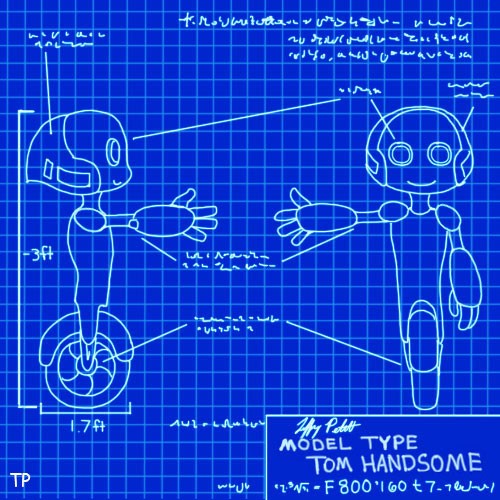
Robots: First three-foot-tall robot that looks like the BTC unicycle robot. It must move around and
stand on only one wheel, have two arms, and glowing eyes. It must be able to travel over all walkable terrain, hop up and down stairs (or at least use a stair's handrail and/or a person's hand to transverse the stairs), and get into and out of vehicles (from sports cars to limousines to tour buses). It must follow the command person at a socially acceptable distance on that person's left side so when they both approach a door, the person can more easily open doors for both of them. It must move when the command person moves and it must stop when the command person stops. It must give and receive gentle hugs from young children, shake hands (when someone else extends out their hand in the way you would do to shake hands), and recognize and return waves.
Future Challenges:
1) "Ham it up" for photographers whenever the robot sees a camera flash and receives permission to do so from the command person. The robots will then do a series of serious and funny poses and doing them in a random order and even slight random variations of each pose.
2) Do a respectful Japanese bow to people who bow to it or when the robot is given the command to bow. When someone bows to the robot, the robot orients itself to that person and returns the bow. When given the command to bow, it must orient itself to the person (not the command person) that is closest and most directly in front of it at that time.
3) Give an animated speech about any of the BTC challenges when given the command to explain them. When explaining this specific challenge, the robot is to use self-effacing humor.
4) Same as Future Challenge #3 but the robot must be able to give these explanations also in Arabic, Bengali, Chinese, Danish, Finnish, French, German, Hindi, Italian, Japanese, Klingon [for Star Trek conventions], Korean, Norwegian, Polish, Portuguese, Russian, Spanish, Swedish, Thai, and Turkish. [As Jack Decker, BTC's creator, hopes to do many public speeches about BTC, the robot being able to give such explanations in the native tongue of the audience can only help the cause.]
5) Give an animated opening hour-long speech about BTC for Jack Decker for when he's to give a dinner speech to a group. The robot travels between the dining tables as it talks with its audio able to wirelessly connect into the room's PA system. [This way Jack gets out of repeating the same speech over and over again and the audience will much prefer the robot giving it anyway. Mr. Decker will then "merely" handle the following Q&A session with the audience during their dessert course and which is of interest to Jack as that is different each time.]
6) Do Future Challenge #5 in Arabic, Bengali, Chinese, Danish, Finnish, French, German, Hindi, Italian, Japanese, Klingon, Korean, Norwegian, Polish, Portuguese, Russian, Spanish, Swedish, Thai, and Turkish. [Jack Decker will then likely use a human translator to help him do the following Q&A session during the dessert course.]
7) Sign its signature on the appropriate spot on photographs and illustrations of itself, especially the illustration used for the bottom of BTC's homepage as the robot and Tiffany both appear in that one. [When Tiffany Petitt attends science fiction conventions, art fairs, comicbook conventions, and technology expositions, the Tom robot can then do a signing session together with her. Attendees to these events will greatly enjoy seeing and photographing them doing so together.]
8) Manipulate the shape of its single wheel so that it can pinch steps and/or form fit a step, hold that form, and use it to pull itself up onto that step. [This requires the development of a dynamic wheel that can control its shape and maintain that shape so the wheel "grips" steps. One possible way the wheel could do so is if its spokes can be pulled in along with the tire of that part of the wheel thus enabling it to "pinch" a step or at least create crease in the tire which it can use as "hold" to pull itself up onto the step. This will require the robot to scan steps that it is approaching and then morph its wheel in the spots that will be touching the steps' edges.
First unicycle robot with a dynamic wheel (see Future Challenge #8) to be able to (from a dead stop, without use of a railing, and maintaining one's balance from beginning to end) drive up and down fifty 7-inch-high steps within:
9) 100 minutes.
10) An hour.
11) Half an hour.
12) 10 minutes.
13) 100 seconds.
14) 10 seconds.
